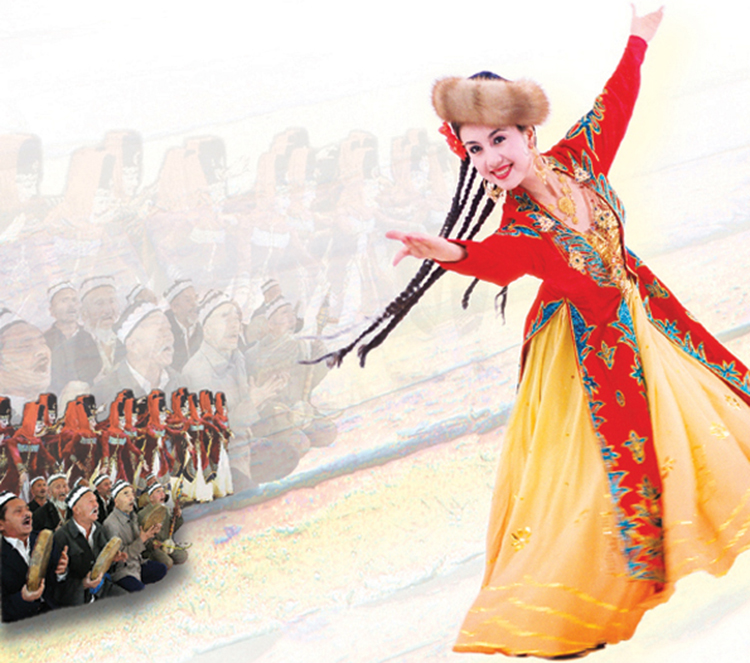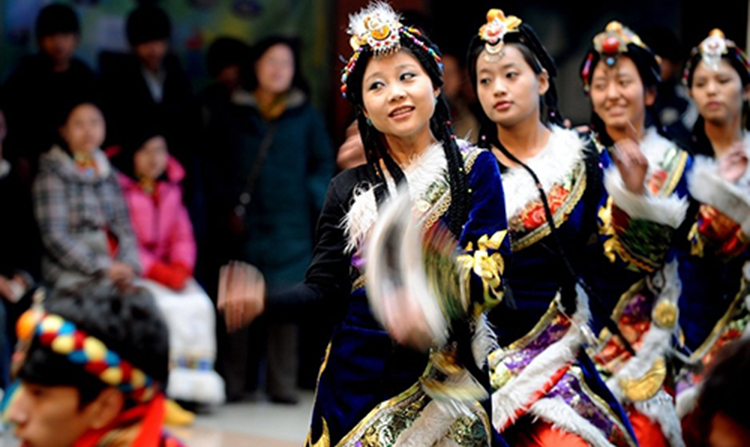Written by: Kang Ruiqin
Posted on: July 28, 2016 |  | 中文
| 中文
Lotus Award Winning Dance
The Lotus Award is one of the most influential awards for the art of dancing in China, an honor that all artists in this field would strive for. On November 29, 2013, the 9th China Lotus Dance Awards were announced in Shanghai, and the dance poem “Forever Meshrep”, created and performed by the Dilinar Art Troupe of the Xinjiang Art Theatre Singing and Dancing Group, drew a lot of attention, winning several prizes, including Gold Medal for the best piece, the special award of the Judging Committee, best costume design, and silver medals for two dancers. Not long ago, two pieces from the New Jade Singing and Dance Group from Hotan Prefecture, Xinjiang, won a gold medal for best folk dance with its “Kunlun Mountain Dream” and a performance bronze medal with a piece named “Girls of Yutian”. Xinjiang dancers proved again that they deserved their reputation as coming from a place called the “Hometown of Singing and Dancing”.
As a traditional dance entertainment for gatherings, Meshrep is indispensable for the Uyghur people of Xinjiang. The award-winning piece Forever Meshrep originally developed from a program performed by renowned dancer Dilinar, the Wedding Meshrep, during the performance tour conducted by the Xinjiang Singing and Dancing Group on the occasion of the 15th Anniversary of Hong Kong’s Return in 2012.
Mr. Aniwar Semat, head of the Xinjiang Singing and Dancing Group introduced the creation process of Forever Meshrep to the reporter on November 29.

Inspired by the success of the primary dance, the creation team of the Xinjiang Singing and Dancing Group refined the piece and put it on stage in Urumqi during the 3rd China Xinjiang International Folk Dance Festival in August of 2013 and received lots of favorable comments. The dancers participating in the Festival from Georgia even asked for a visit to the rehearsal of the dance. Later, just around the Korban Eid Festival in October, a piece of news came, saying that Forever Meshrep was included in the shortlist of the year’s Lotus Award. The director and choreographers went to Beijing and consulted senior experts for suggestions on further improving the dance to win the competition. Finally, their hard work harvested its satisfactory reward. From among dozens of dances with huge investments, the small cost production Forever Meshrep became one of the biggest winners.
With the sound of a child crying, the graceful dance starts under the moonlight. Spring comes with aspiration for prosperity of crops and breeding, people dance at the Meshrep in the green fields; in autumn fields waved with golden wheat, they dance at the Meshrep for the harvest…. People work and dance in fields and the desert, under the grape vines and the sky. Basically, it is a dance representative of their beautiful life.
The dancing poem takes the life of a Uyghur couple as its main focus, and incorporates the four most important moments in their lives, namely, the first meeting, falling in love, the wedding and child-birth; these are presented in 7 chapters: the prelude, the ending, and five representative Meshrep episodes with scenes of cultivation, relaxation, harvest, punishment and praise, wedding and birth celebration, natural landscapes, etc., all displayed vividly and incisively through different dance forms.

“Why we named it as ‘Forever Meshrep’?” said Mr. Aniwar Semat, “Because Meshrep is the tradition that Uyghur people have had for generations; our ancestors held it during various important occasions in our lives and we hold it now; and so will our next generation. No matter whether it is in the past, present, or in the future; just like Meshrep witnesses the birth of a child, the growth and reproduction as always will last for as long as life goes on.”
The Lotus Awarding Committee gave the following comment on the dance of Forever Meshrep: “This work is a refined production full of ethnic flavor, expressing strong ethnic sentiment, as well as positive energy. It is impressively performed and has received enthusiastic feedback from the audience.”
Dilinar Abdullar, the head dancer and choreographer, believes that the high appraisal given by professionals and the audience was actually the affirmation of the cultural development and prosperity of Xinjiang. The environment of a harmonious coexistence of diverse cultures was what enabled such a wonderful creation with rich ethnic and cultural connotations and presentation.
You may also like: